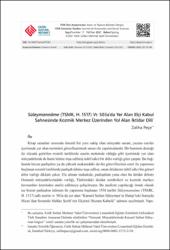Süleymannâme (TSMK, H. 1517) Vr. 503a’da Yer Alan Elçi Kabul Sahnesinde Kozmik Merkez Üzerinden Yol Alan İktidar Dili
Künye
PEÇE, Zaliha. "Süleymannâme (TSMK, H. 1517) Vr. 503a’da Yer Alan Elçi Kabul Sahnesinde Kozmik Merkez Üzerinden Yol Alan İktidar Dili". FSM İlmi Araştırmalar İnsan ve Toplum Bilimleri Dergisi, 17 (2021): 73-110.Özet
Kitap sanatları arasında önemli bir yere sahip olan minyatür sanatı, yazma eserler
içerisinde yer alan metinleri görselleştirmek amacı ile yapılmışlardır. Bir haminin desteği
ile vücuda getirilen resimli tarihlerde eserin metninde olduğu gibi içerisinde yer alan
minyatürlerde de hami lehine inşa edilmiş taltif edici bir dilin varlığı göze çarpar. Bu bağlamda
bizzat padişahın ya da yüksek makamdaki devlet görevlilerinin emri ile yapımına
başlanan resimli tarihlerde padişah lehine inşa edilen, onun iktidarını taltif edici bir görsel
dilin varlığı dikkati çeker. Ele alınan makalede, padişahtan yana olan bu iktidar dilinin
Osmanlı minyatürlerindeki varlığı, Türklerdeki iktidar sembolleri ve kozmik merkez
kavramları üzerinden analiz edilmeye çalışılmıştır. Bu analizin yapılacağı örnek olarak
ise bizzat padişahın talimatı ile yapımına başlanan 1558 tarihli Süleymannâme (TSMK,
H. 1517) adlı eserin vr. 503a da yer alan “Kanunî Sultan Süleyman’ın Halep’teki Sarayda
Hicaz’dan Sorumlu Mekke Şerifi’nin Elçisini Huzura Kabulü” sahnesi seçilmiştir. Yapılan bu analiz sonucunda mevcut minyatürde merkez ve iktidar sembollerinin varlığından
müteşekkil bir dikey kompozisyon şemasının varlığına rast gelinmiştir. Miniature art, which has an important place among the book arts, was created with
the aim of visualizing the texts in the manuscripts. In the illustrated dates brought to life
with the support of a patron, the presence of a gratifying language built in favor of the
patron stands out in the miniatures included as well as in the text of work. In this context,
the presence of a visual language built in favor of the sultan on the illustrated dates, which
were started to be created by the order of the sultan himself or the state officials in high
office, that gratifies his power, draws attention. In the article discussed, the existence
of this language of power in Ottoman miniatures were tried to be analyzed through the
concepts of symbols of power in Turks and the cosmic center. As the example through
which this analysis was to be done, the scene “Suleiman the Magnificent Receiving the
Messenger of the Sharif of Mecca Responsible of Hijaz in the Palace in Aleppo” in the
vr. 503a of the 1558 dated work d Suleiman-nama (Süleymannâme) (TSMK, H. 1517),
the making of which had started by the order of sultan, was selected. As a result of this
analysis, a vertical composition scheme consisting of the symbols of center and power
has been found in the present miniature.



















